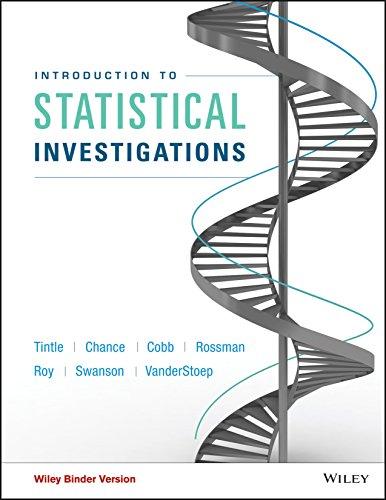Recall Exercise 9.1.18 about the article in the Journal of the American Medical Association (Dansinger, Griffith, Gleason,
Question:
Recall Exercise 9.1.18 about the article in the Journal of the American Medical Association (Dansinger, Griffith, Gleason, et al., 2005) that reported on a randomized, comparative experiment in which 160 subjects were randomly assigned to one of four popular diet plans: Atkins, Ornish, Weight Watchers, and Zone (40 subjects per diet). Data for the 93 subjects who completed the 12-month study are in data file Diets2. The file contains which diet the subject was on and the weight loss in kilograms (positive values indicate weight loss and negative values indicate weight gain).
a. State the null and alternative hypotheses in the context of the study.
b. Use technology (either an applet or statistical soft ware) to find and report the value of the F-statistic for these data.
c. Recall that the theory-based test of significance in this scenario is called the ANOVA test or F-test. Use technology (either an applet or statistical soft ware) to implement the ANOVA test to test whether weight loss differs significantly for any of the diets. Be sure to report a p-value.
d. Based on the p-value reported in part (c), state an appropriate conclusion in the context of the study. Be sure to comment on statistical significance, causation, and generalization along with how you are making your decision.
e. State the conditions under which the results from the theory-based ANOVA test would be valid. In the context of this study, is it valid to use the ANOVA test? Explain how you are deciding.
f. If appropriate, perform follow-up analysis. If you do not think follow-up analysis is appropriate, explain why not.
g. How do your results compare with part (c) and Exercise 9.1.18?
Data from exercise 9.1.18
Which diet is best? A fairly recent article in the Journal of the American Medical Association (Dansinger, Griffith, Gleason, et al., 2005) reported on a randomized, comparative experiment in which 160 subjects were randomly assigned to one of four popular diet plans: Atkins, Ornish, Weight Watchers, and Zone (40 subjects per diet). These subjects were recruited through newspaper and television advertisements in the greater Boston area; all were overweight or obese with body mass index values between 27 and 42. Data for the 93 subjects who completed the 12-month study are in data file Diets2. The file contains which diet the subject was on and the weight loss in kilograms (positive values indicate weight loss and negative values indicate weight gain).
Step by Step Answer:

Introduction To Statistical Investigations
ISBN: 9781118172148
1st Edition
Authors: Beth L.Chance, George W.Cobb, Allan J.Rossman Nathan Tintle, Todd Swanson Soma Roy





